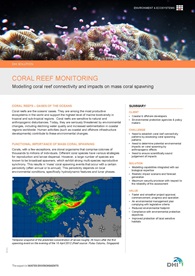Modelling coral reef connectivity and impacts on mass coral spawning
To investigate coral connectivity in the coastal waters of Singapore, an Agent-based Model (ABM) of coral larvae was developed and implemented via our integrated MIKE ECO Lab software module.
 To investigate coral connectivity in the coastal waters of Singapore, an Agent-based Model (ABM) of coral larvae was developed and implemented via our integrated MIKE ECO Lab software module. These comprehensive and flexible modelling tools enable faster and smoother project approval, and improved protection of local coral habitats, among other things.
To investigate coral connectivity in the coastal waters of Singapore, an Agent-based Model (ABM) of coral larvae was developed and implemented via our integrated MIKE ECO Lab software module. These comprehensive and flexible modelling tools enable faster and smoother project approval, and improved protection of local coral habitats, among other things.
A large number of coral species are known to be broadcast spawners, which exhibit strong multi-species reproductive synchrony. This results in ‘mass’ coral spawning events that are believed to be an important mechanism for maintaining coral populations. Thus, they help predict and understand the dispersal patterns in relation to individual reefs as well as the connectivity between reefs.
Thus there is a need to:
- establish coral reef connectivity patterns by assessing coral spawning patterns
- determine potential environmental impacts on coral spawning by anthropogenic effects
- ensure scientifically sound judgement of impacts
MIKE ECO Lab supports a coupled Eulerian-Lagrangian framework allowing for an accurate representation of hydrodynamics and water quality within a spatially complex system. Our comprehensive and flexible modelling tools enable easy development of tailor-made solutions to better understand complex biological/ecological problems. With these tools, we offer robust and reliable outcomes for our clients (for instance, by allowing development plans to advance in a sustainable manner, while protecting valuable coral reefs).
Read more